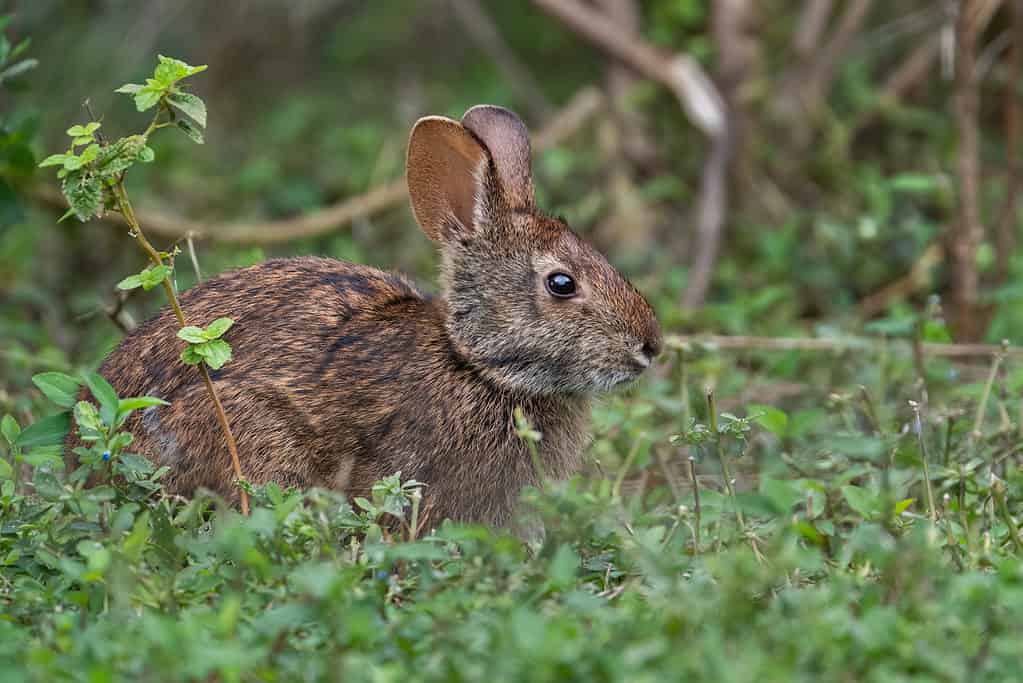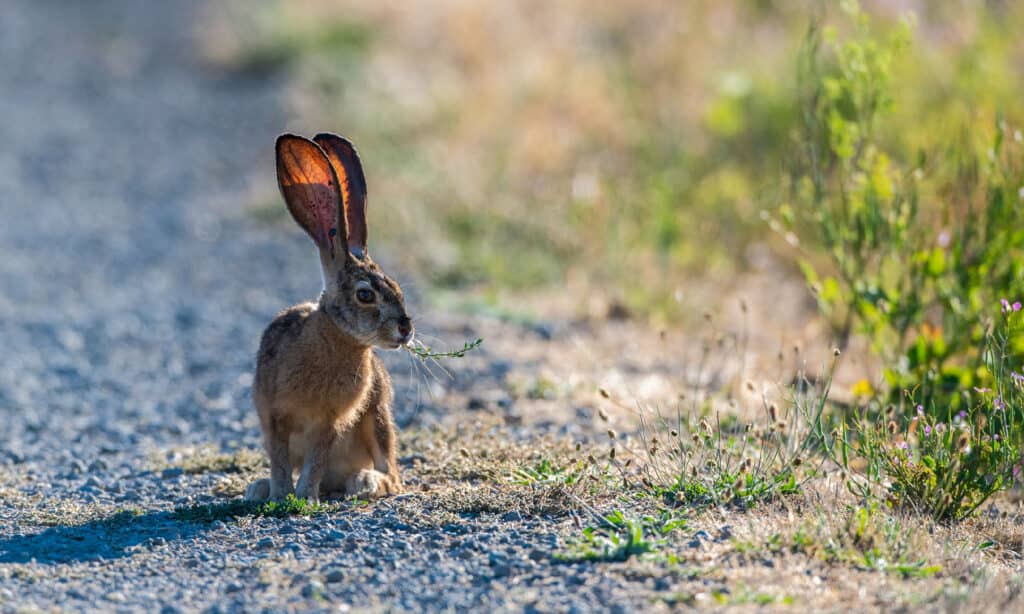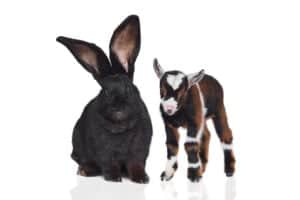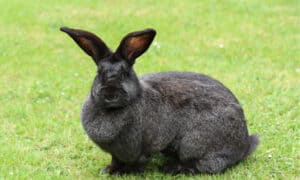Did you know that rabbits make nests or that they sometimes eat twigs and bark? Rabbits are fascinating creatures, and there are a couple of species hopping around Florida that we want you to know about. One is common, and the other is a bit trickier to see in their natural habitat. There’s also the famously large hare that lives in the Sunshine State, the black-tailed jackrabbit.
What tricks do these rabbits use to survive? And where are you most likely to see them in their natural habitats? Let’s find out! Follow along to learn all about the wild rabbits in Florida.
Eastern Cottontail

If the wild rabbit you see in Florida has a puffy white tail, it’s an eastern cottontail.
©Rabbitti/Shutterstock.com
- Abundant throughout Florida
- Prefer briar patches, fields, and forests
- Active during sunset, exploring areas with brush cover
- Identified by puffy white tail
- Brown-gray color, 2 to 4 pounds, up to 17 inches
Eastern cottontails are one of the most popular types of wild rabbits in Florida. These well-known bunnies get their name from their puffy white tail. The rest of their body is a brown-gray color. As for size, full-grown adults are on the smaller side. They weigh between 2 to 4 pounds and rarely grow past 17 inches in length.
The best time to see cottontails is as the sun’s setting. They love exploring areas with plenty of brush to provide cover. Some of their favorite stomping grounds include briar patches, fields, and forests.
During the day, these rabbits spend their time resting, grooming, and of course, hiding. Wwls, coyotes, weasels, hawks, and bobcats are just a few of the predators they have to worry about.
Cottontails might seek refuge in a safe space beneath a log or tuck themselves away in the brush. Here they’ll pass the time by sleeping and cleaning themselves. Occasionally they might check their surroundings by standing up on their hindlegs, with their forepaws held close to the chest.
As for diet, eastern cottontails are herbivores, which means they eat all sorts of plants and vegetation. When there isn’t any green vegetation around, they’ll use bark and twigs to survive. In the wild, they usually have a lifespan of around three years.
As solitary creatures, eastern cottontails spend the majority of those three years alone. They hop around in a home range that’s anywhere from five to eight acres in size, with males tending to have larger home ranges than females.
When you see a rabbit in Florida, chances are it’ll be an eastern cottontail. Marsh rabbits are much more elusive and live further in the brush. So, if you happen to spot one, consider yourself lucky.
Marsh Rabbit

Unlike most other rabbits, marsh rabbits prefer walking over hopping.
©iStock.com/MattCuda
- Lives near fresh and brackish water
- Less common to see
- Slightly smaller compared to cottontails
- No white puffy tail
- Weighs less than 4 pounds
Is that a marsh rabbit or a cottontail? It can be difficult to tell these wild rabbits apart. But thankfully there’s a trick for making a fast ID, just look at their tail. If you don’t see a white puffy tail that looks like a big cotton ball, then you’re looking at a marsh rabbit. Marsh rabbits have a brown, somewhat gray tail. Marsh rabbits also appear slightly smaller and more sleek compared to the extra hairy cottontail.
Along with the tail, another difference between the two species is their swimming abilities. Marsh rabbits are strong skilled swimmers, a skill that helps them survive in and around wetlands. Being able to swim comes in handy when escaping predators such as foxes, alligators, owls, and foxes.
Was the rabbit you saw hopping or walking? If it was walking, you might be a marsh rabbit. This species is an unusual type of bunny who prefers walking over hopping.
If you live in Florida, and you’re near a body of water, you could try setting up a trail cam. Chances are you’ll catch a few cottontails hopping around, and if you’re lucky, the more elusive marsh rabbit.
Black-Tailed Jack Rabbit

The wild hare species living in Florida is the black-tailed jackrabbit.
©iStock.com/zhuclear
- Not a rabbit but a hare
- Native to the Southeastern U.S. and Mexico
- Capable of running as fast as 30 mph
- Brought to Florida to train greyhounds for racing
- Can weigh nearly 8 pounds and be 25 inches long
Although not a rabbit at all, we had to include the black-tailed jackrabbit. Black-tailed jackrabbits have a brown-gray coat with black markings, and the edges of their ears are also black. These hares aren’t native to Florida. This species is native to the Southeastern part of the United States and Mexico. About a century ago they were brought in to help train greyhounds for racing.
You’ll know in an instant if you’re looking at a hare vs. a rabbit. In comparison, hares are humongous, with full-grown adults reaching double, and even triple the size of regular rabbits. An eastern cottontail usually tops out at 4 pounds, but a black-tailed jackrabbit can weigh nearly 8 pounds. And while a cottontail isn’t usually longer than 17 inches, a jackrabbit can easily be 2 feet long.
At top speeds, they can run as fast as 40 mph! This speed helps them escape their many predators. These athletic creatures can live as long as five years in the wild. A few of the animals that eat jackrabbits include eagles, hawks, foxes, and bobcats.
The photo featured at the top of this post is © Rabbitti/Shutterstock.com
Thank you for reading! Have some feedback for us? Contact the AZ Animals editorial team.






